Processing Small-Sized Trees at Landing by a Double-Grip Machine: A Case Study on Productivity, Cardiovascular Workload and Exposure to Noise
Abstract
1. Introduction
2. Materials and Methods
2.1. Study Area, Harvesting System and Work Organization
2.2. Data Collection
2.3. Data Processing and Analysis
- -
- A-weighted sound pressure level (Laeq), computed at task group (processing and non-processing tasks), daily and overall resolution;
- -
- A-weighted sound pressure level (Laeq, T), weighted by the number of days of observation;
- -
- Exposure to noise normalized for a nominal 8-h working day (LEX, 8h).
3. Results
3.1. Time Consumption and Estimates of Productive Performance
3.2. Cardiovascular Workload and Exposure to Noise
4. Discussion
5. Conclusions
Author Contributions
Funding
Data Availability Statement
Acknowledgments
Conflicts of Interest
References
- Heinimann, H.R. Forest operations engineering and management—The ways behind and ahead of a scientific discipline. Croat. J. For. Eng. 2007, 28, 107–121. [Google Scholar]
- Marchi, E.; Chung, W.; Visser, R.; Abbas, D.; Nordfjell, T.; Mederski, P.S.; McEwan, A.; Brink, M.; Laschi, A. Sustainable forest operations (SFO): A new paradigm in a changing world and climate. Sci. Total Environ. 2018, 634, 1385–1397. [Google Scholar] [CrossRef] [PubMed]
- Oprea, I. Tehnologia exploatării lemnului (Timber Harvesting Technology); Transilvania University Press: Brasov, Romania, 2008; 273p. [Google Scholar]
- Stankić, I.; Poršinsky, T.; Tomašić, Ž.; Tonković, I.; Frntić, M. Productivity models for operational planning of timber forwarding in Croatia. Croat. J. For. Eng. 2012, 33, 61–78. [Google Scholar]
- Borz, S.A.; Rommel, D.; Ziesak, M.; Vasiliauskas, G. Operational requirements and preferences towards forwarder technology. Bull. Transilv. Univ. Bras. Ser. II For.-Wood Ind.-Agric. Food Eng. 2019, 121, 1–12. [Google Scholar] [CrossRef]
- Zinkevičius, R.; Steponavičius, D.; Vitunskas, D.; Činga, G. Comparison of harvester and motor-manual logging in intermediate cuttings of deciduous stands. Turk. J. Agric. For. 2012, 36, 591–600. [Google Scholar]
- Axelsson, S.-A. The Mechanization of logging operations in Sweden and its effect on occupational safety and health. J. For. Eng. 1998, 9, 25–31. [Google Scholar]
- Bell, J.L. Changes in logging injury rates associated with use of feller-bunchers in West Virginia. J. Saf. Res. 2002, 33, 463–471. [Google Scholar] [CrossRef]
- Cheţa, M.; Marcu, M.V.; Borz, S.A. Workload, exposure to noise and risks of musculoskeletal disorders: A case study of motor-manual tree felling and processing in poplar clear cuts. Forests 2018, 9, 300. [Google Scholar] [CrossRef]
- Potočnik, I.; Poje, A. Forestry ergonomics and occupational safety in high ranking scientific journals from 2005–2016. Croat. J. For. Eng. 2017, 38, 291–310. [Google Scholar]
- Moskalik, T.; Borz, S.A.; Dvorák, J.; Ferencik, M.; Glushkov, S.; Muiste, P.; Lazdinš, A.; Styranivsky, O. Timber harvesting methods in Eastern European countries: A review. Croat. J. For. Eng. 2017, 38, 231–241. [Google Scholar]
- Mederski, P.; Borz, S.A.; Đuka, A.; Lazdinš, A. Challenges in forestry and forest engineering—Case studies from four countries in East Europe. Croat. J. For. Eng. 2017, 42, 117–134. [Google Scholar] [CrossRef]
- Borz, S.A.; Birda, M.; Ignea, G.; Popa, B.; Campu, V.R.; Iordache, E.; Derczeni, R.A. Efficiency of a Woody 60 processor attached to a Mounty 4100 tower yarder when processing coniferous timber from thinning operations. Ann. For. Res. 2014, 57, 333–345. [Google Scholar] [CrossRef]
- Nurminen, T.; Korpunen, H.; Uusitalo, J. Time consumption analysis of the mechanized cut-to-length harvesting system. Silva Fenn. 2006, 40, 335–363. [Google Scholar] [CrossRef]
- Väätäinen, K.; Ala-Fossi, A.; Nuutinen, Y.; Roser, D. The effect of single grip harvester’s log bunching on forwarder efficiency. Balt. For. 2006, 12, 64–69. [Google Scholar]
- Eriksson, M.; Lindroos, O. Productivity of harvesters and forwarders in CTL operations in northern Sweden based on large follow-up datasets. Int. J. For. Eng. 2014, 25, 179–200. [Google Scholar] [CrossRef]
- Mederski, P.S.; Bembenek, M.; Karaszewski, Z.; Łacka, A.; Szczepańska-Álvarez, A.; Rosińska, M. Estimating and modelling harvester productivity in pine stands of different ages, densities and thinning intensities. Croat. J. For. Eng. 2016, 37, 27–36. [Google Scholar]
- Apafaian, A.I.; Proto, A.R.; Borz, S.A. Performance of a mid-sized harvester-forwarder system in integrated harvesting of sawmill, pulpwood and firewood. Ann. For. Res. 2017, 60, 227–241. [Google Scholar]
- Norihiro, J.; Ackerman, P.; Spong, B.D.; Längin, D. Productivity model for cut-to-length harvester operation in South African Eucalyptus pulpwood plantations. Croat. J. For. Eng. 2018, 39, 1–13. [Google Scholar]
- Spinelli, R.; Magagnotti, N.; Labelle, E.R. The effect of new silvicultural trends on the mental workload of harvester operators. Croat. J. For. Eng. 2020, 41, 177–190. [Google Scholar] [CrossRef]
- Prinz, R.; Väätäinen, K.; Routa, J. Cutting duration and performance parameters of a harvester’s sawing unit under real working conditions. Eur. J. For. Res. 2020, 1. [Google Scholar] [CrossRef]
- Poje, A.; Grigolato, S.; Potočnik, I. Operator exposure to noise and whole-body vibration in a fully mechanized CTL forest harvesting system in karst terrain. Croat. J. For. Eng. 2019, 40, 139–150. [Google Scholar]
- Glöde, D. Single- and double-grip harvesters: Productive measurements in final cutting of shelterwood. Int. J. For. Eng. 1999, 10, 63–74. [Google Scholar]
- Hiesl, P.; Benjamin, J.G. Applicability of international harvesting equipment productivity studies in Maine, USA: A literature review. Forests 2013, 4, 898–921. [Google Scholar] [CrossRef]
- Picchio, R.; Proto, A.R.; Civitarese, V.; Di Marzio, N.; Latterini, F. Recent contributions of some fields of the electronics in development of forest operations technologies. Electronics 2019, 8, 1465. [Google Scholar] [CrossRef]
- Marinello, F.; Proto, A.R.; Zimbalatti, G.; Pezzuolo, A.; Cavalli, R.; Grigolato, S. Determination of forest road surface roughness by Kinect depth imaging. Ann. For. Res. 2017, 60, 217–226. [Google Scholar] [CrossRef]
- Castro Pérez, S.N.; Zurita Vintimilla, M.C.; Borz, S.A. Performance of a double-grip HYPRO 775 machine in processing small-sized pine wood. Bull. Transilv. Univ. Bras. Ser. II For.-Wood Ind.-Agric. Food Eng. 2020, 13, 19–34. [Google Scholar]
- HYPRO 2020. Available online: https://www.hypro.se/en/products/tractor-processors/hypro-755-tractor-processor (accessed on 7 January 2021).
- Product Portfolio of Aglomerados Cotopaxi S.A. Available online: https://www.cotopaxi.com.ec/en/productos (accessed on 7 January 2021).
- Directive 2003/10/CE of the European Parliament and European Council. Available online: http://eur-lex.europa.eu/legal-content/RO/TXT/HTML/?uri=CELEX:02003L0010-20081211&from=EN (accessed on 7 January 2021).
- Neitzel, R.; Fligor, B. Determination of Risk of Noise-Induced Hearing Loss Due to Recreational Sound: Review. Make Listening Safe, World Health Organization. Available online: https://www.who.int/pbd/deafness/Monograph_on_determination_of_risk_of_HL_due_to_exposure_to_recreational_sounds.pdf?ua=1 (accessed on 7 January 2021).
- EXTECH®, 407760: USB Sound Level Datalogger. Available online: http://www.extech.com/display/?id=14225 (accessed on 7 January 2021).
- Helander, M. A Guide to Human Factors and Ergonomics, 2nd ed.; CRC Press Taylor & Francis Group: Boca Raton, FL, USA; London, UK; New York, NY, USA, 2006; pp. 224–255. [Google Scholar]
- Marogel-Popa, T.; Cheta, M.; Marcu, M.V.; Duta, C.I.; Ioras, F.; Borz, S.A. Manual cultivation operations in poplar stands: A characterization of job difficulty and risks of health impairment. Int. J. Environ. Res. Public Health 2019, 16, 1911. [Google Scholar] [CrossRef]
- Borz, S.A.; Talagai, N.; Cheta, M.; Chiriloiu, D.; Montoya, A.V.G.; Vizuete, D.D.C.; Marcu, M.V. Physical strain, exposure to noise and postural assessment in motor-manual felling of willow short rotation coppice: Results of a preliminary study. Croat. J. For. Eng. 2019, 40, 377–388. [Google Scholar] [CrossRef]
- Lequeuz, B.; Uzan, C.; Rehman, M.B. Does resting heart rate measured by the physician reflect the patient’s true resting heart rate? White-coat heart rate. Indian Heart J. 2018, 70, 93–98. [Google Scholar] [CrossRef] [PubMed]
- Ottaviani, G.; Talbot, B.; Nitteberg, M.; Stampfer, K. Workload benefits of using synthetic rope strawline in cable yarder rigging in Norway. Croat. J. For. Eng. 2010, 32, 561–569. [Google Scholar]
- Björheden, R.; Apel, K.; Shiba, M.; Thompson, M. IUFRO Forest Work Study Nomenclature; Department of Operational Efficiency, Swedish University of Agricultural Science: Grapenberg, Sweden, 1995; 16p. [Google Scholar]
- Borz, S.A. Evaluarea Eficienţei Echipamentelor şi Sistemelor Tehnice în Operaţii Forestiere; Lux Libris Publishing House: Braşov, Romania, 2008; 252p. [Google Scholar]
- Acuna, M.; Bigot, M.; Guerra, S.; Hartsough, B.; Kanzian, C.; Kärhä, K.; Lindroos, O.; Magagnotti, N.; Roux, S.; Spinelli, R.; et al. Good Practice Guidelines for Biomass Production Studies; Magagnotti, N., Spinelli, R., Eds.; CNR IVALSA: Sesto Fiorentino, Italy, 2012; Available online: http://www.forestenergy.org/pages/cost-action-fp0902/good-practice-guidelines/ (accessed on 15 April 2018).
- Poje, A.; Spinelli, R.; Magagnotti, N.; Mihelic, M. Exposure to noise in wood chipping operations under the conditions of agro-forestry. Int. J. Ind. Ergon. 2015, 50, 151–157. [Google Scholar] [CrossRef]
- Giurgiu, V.; Decei, I.; Drăghiciu, D. Metode şi Tabele Dendrometrice; Ceres Publishing House: Bucharest, Romania, 2004; 575p. [Google Scholar]
- Visser, R.; Spinelli, R. Determining the shape of productivity function for mechanized felling and felling-processing. J. For. Res. 2012, 17, 397–402. [Google Scholar] [CrossRef]
- Ministerul Industrializării Lemnului şi a Materialelor de Construcţii. Norme şi Normative de Muncă Unificate în Exploatările Forestiere; Ministerul Industrializării Lemnului şi a Materialelor de Construcţii: Bucharest, Romania, 1989; 491p. [Google Scholar]
- Inoue, K.; Kobayashi, H. Operators’ physical strain in operating the high proficient forestry machines. J. For. Res. 1996, 1, 111–115. [Google Scholar] [CrossRef]
- Silayo, D.S.A.; Kiparu, S.S.; Mauya, E.W.; Shemwetta, D.T.K. Working conditions and productivity under private and public logging companies in Tanzania. Croat. J. For. Eng. 2010, 31, 65–74. [Google Scholar]
- Rodahl, K. The Physiology of Work, 1st ed.; Taylor and Francis: London, UK, 1989; pp. 335–336. [Google Scholar]
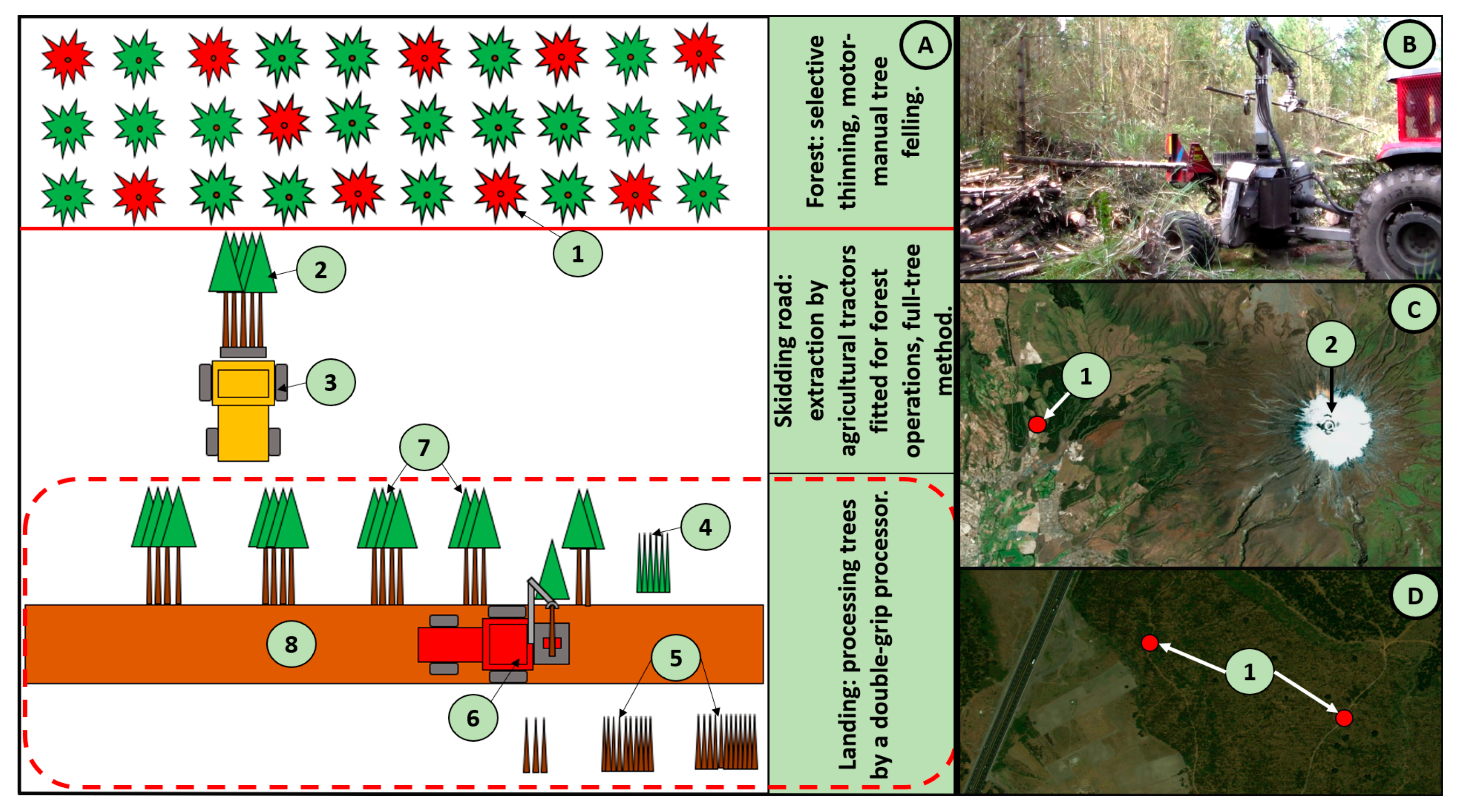
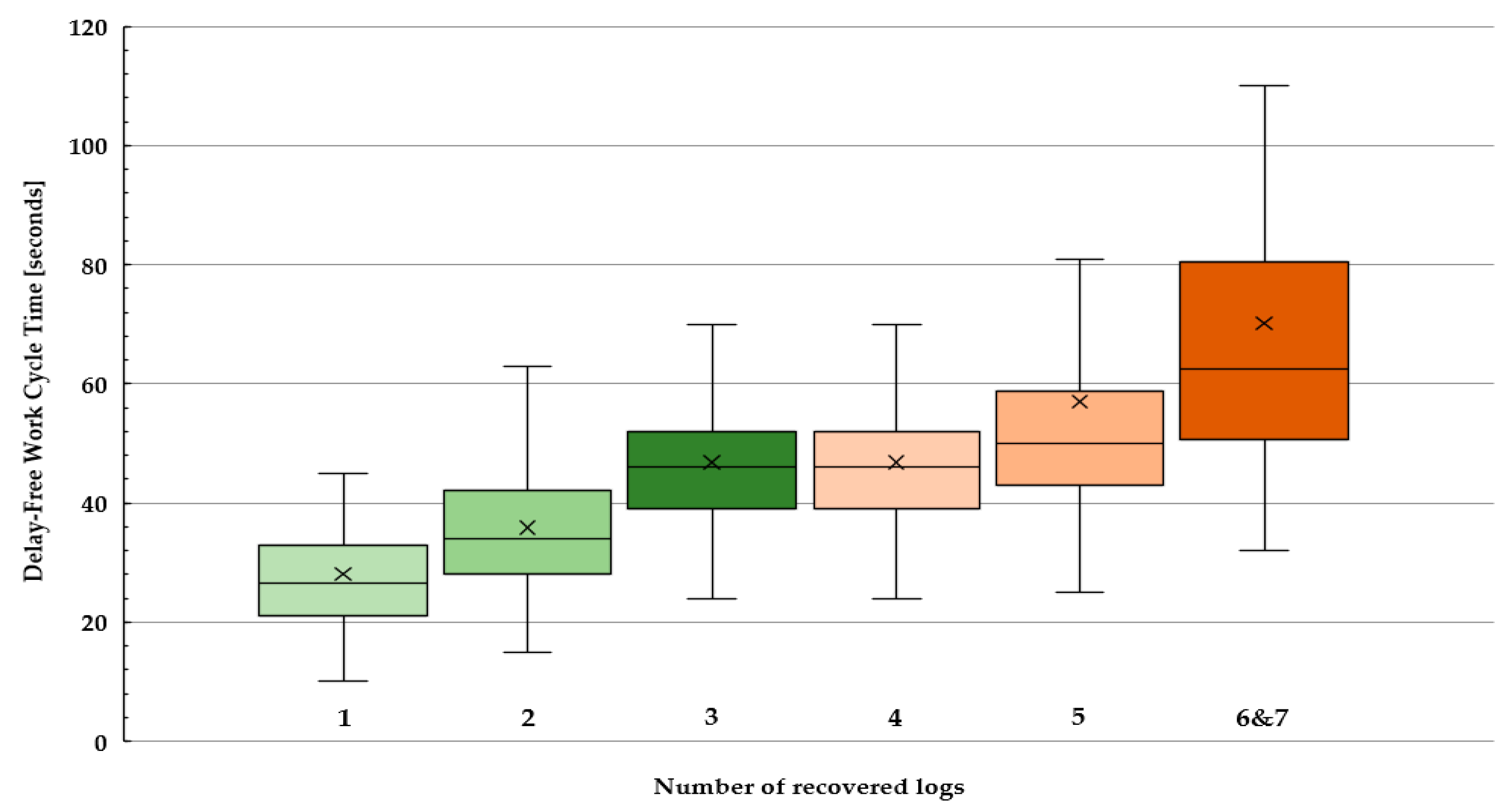
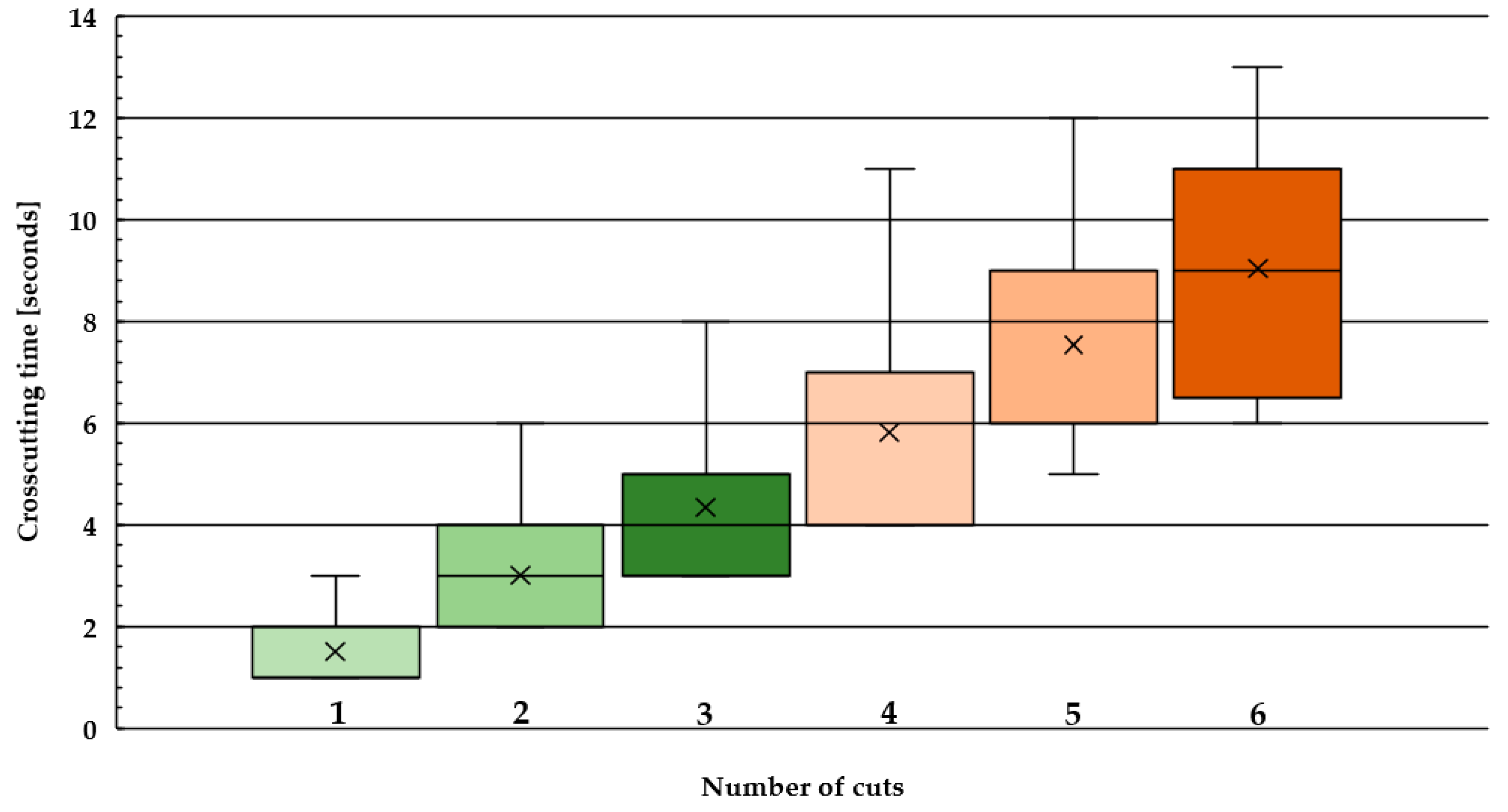
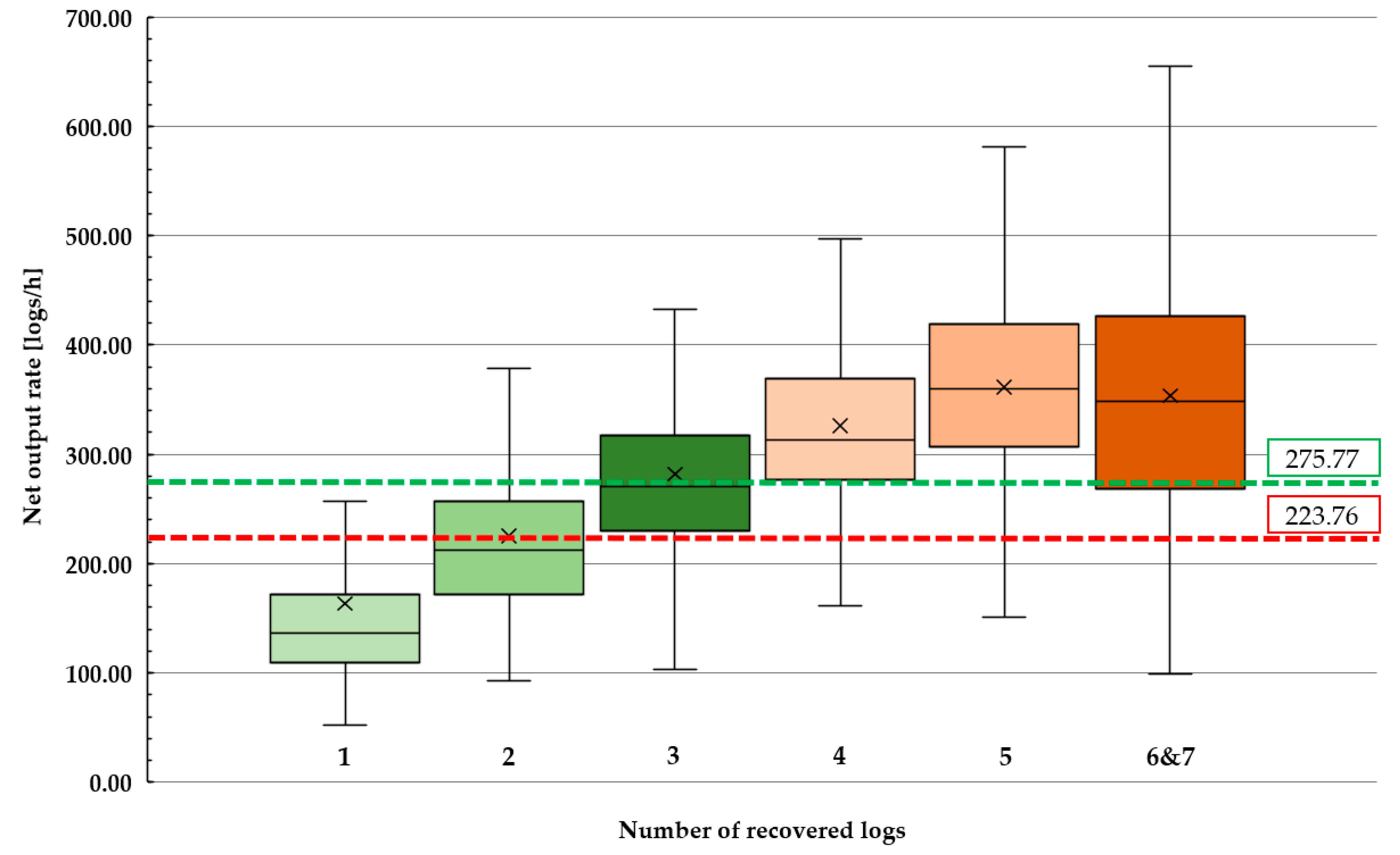
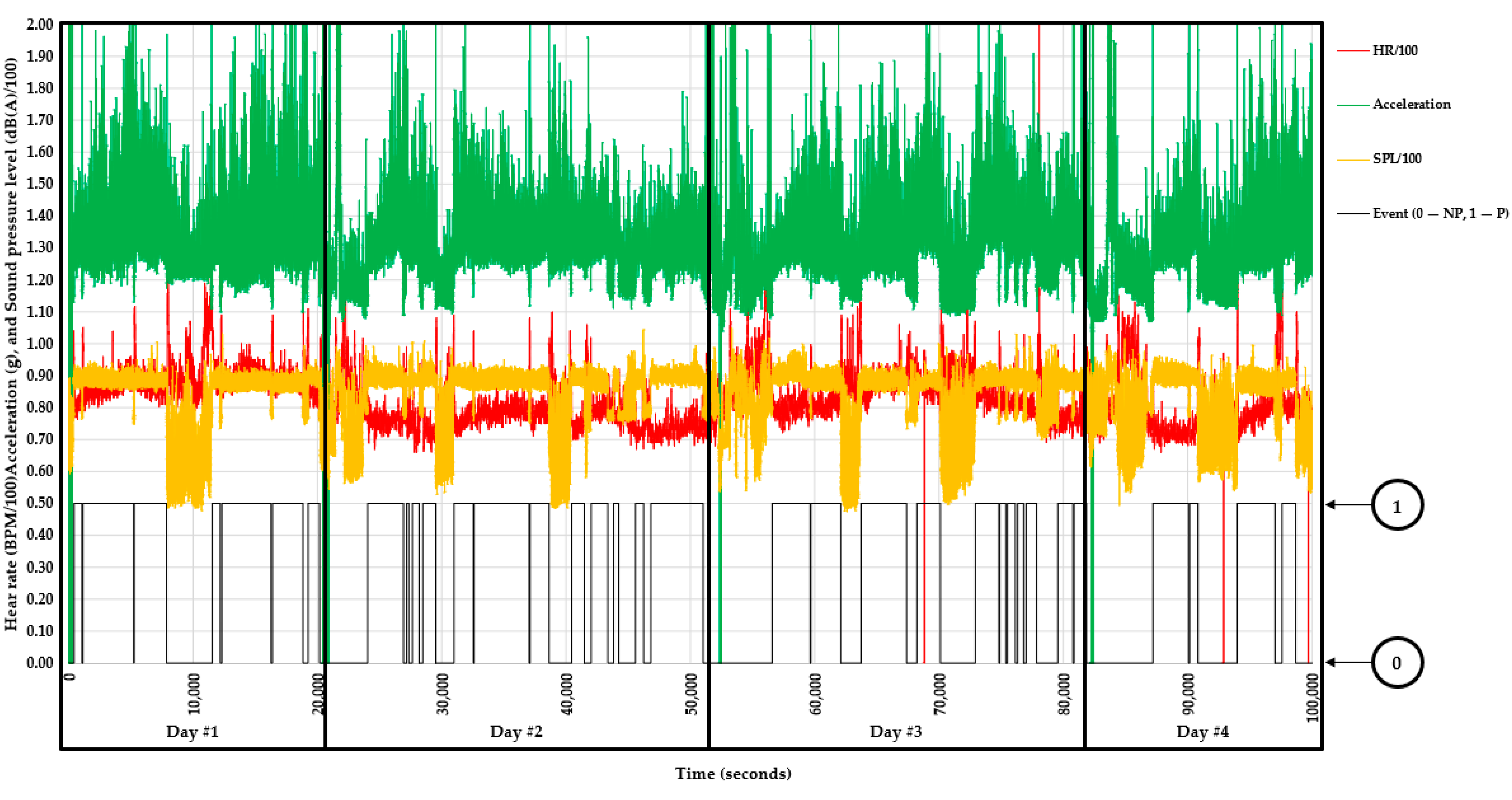
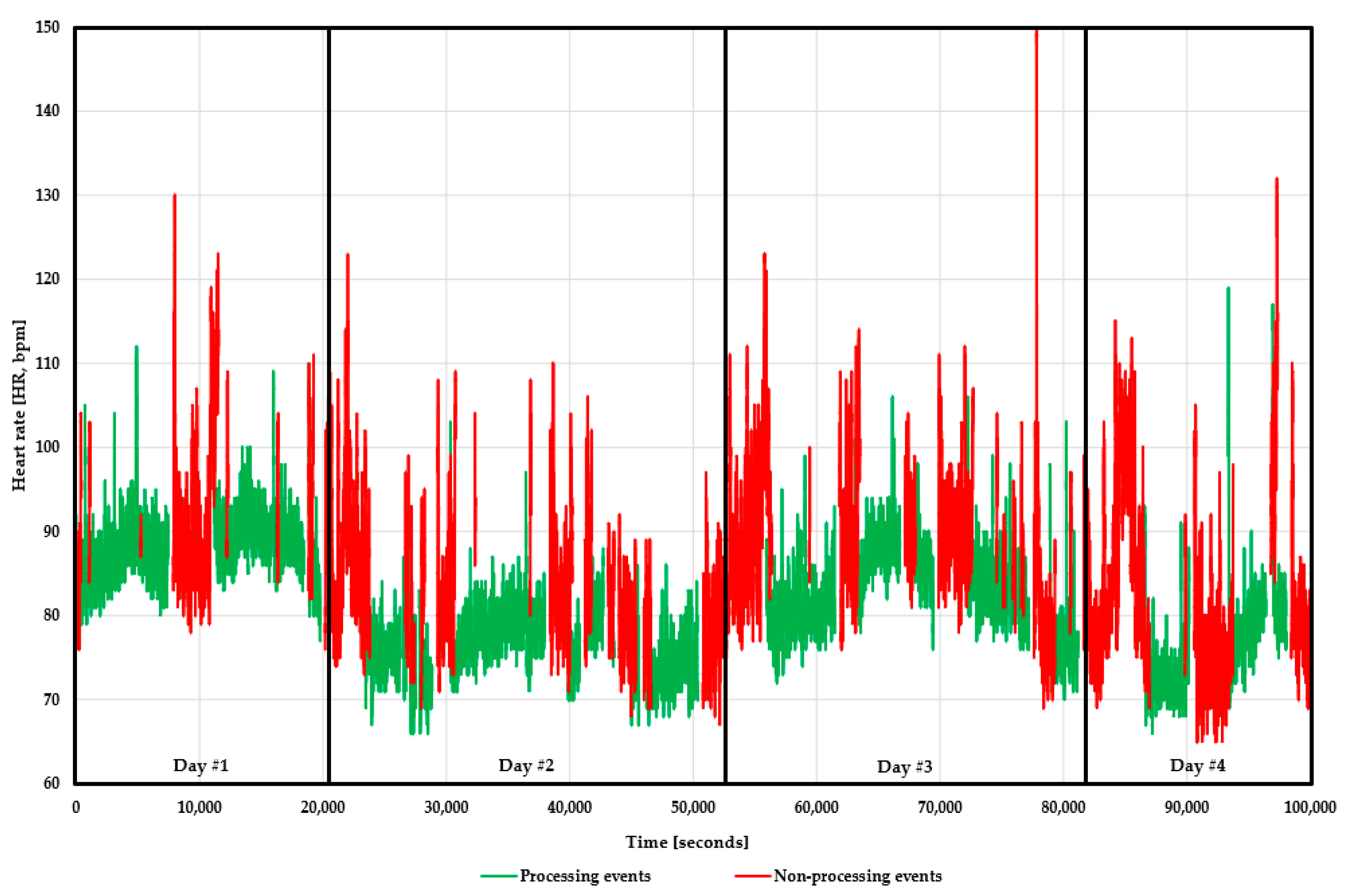
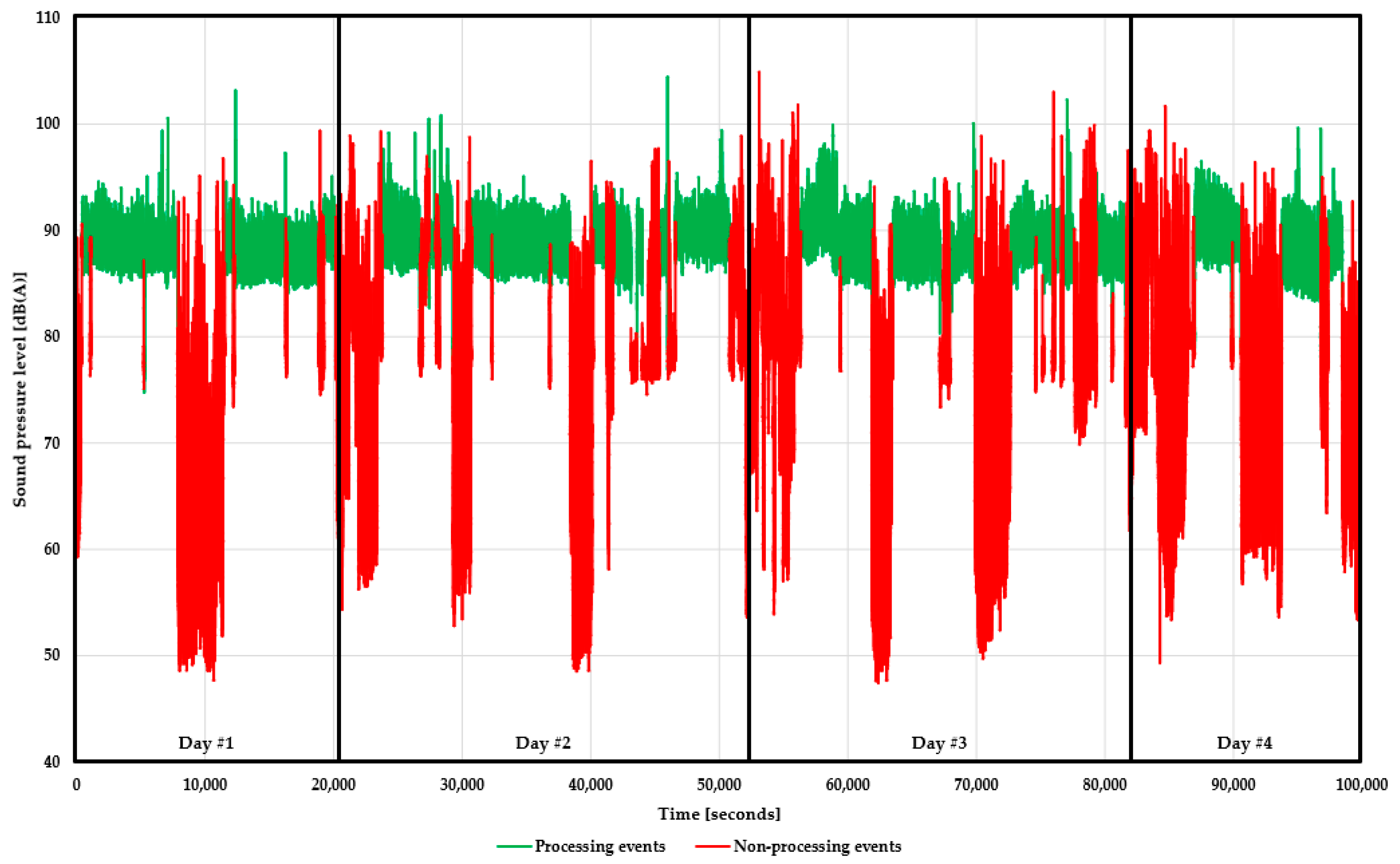
| Work (Time) Element | Description | Procedures Used in Documentation |
|---|---|---|
| Recorded time | All the time covered by the media files | Documented in seconds, as the total amount |
| Undocumented time | Portion of the time covered by the media files which could not be documented due to camera movement or other events | Documented in seconds, as the total amount |
| Documented time | Portion of the media files for which codes could be attributed following the time and motion study procedures | Documented in seconds, as the total amount |
| Delays | Portion of the time in which no work was carried out due to events caused by personal or mechanical reasons. The category excludes the time spent in other events such as long rest breaks, meal breaks and other, for which the data was documented by the rest of the used devices | Documented in seconds, accounted as event-based and reported as the total amount |
| Moving to next pile | Non-cyclic time in which the machine was driven from a given pile to a location at which a new log pile was started. It started when the machine started to move and it ended when machine reached a new location | Documented in seconds, accounted as event-based and reported as the total amount |
| Piling tops & slash | Non-cyclic time in which the crane was used to pile the tops and slash resulting from tree processing. It occurred several times, but not on a cyclic basis according to the delay-free work cycle definition given in the following. It started when the crane started its movement to grip tops and slash and it ended when the crane reached to a location of starting a new work cycle | Documented in seconds, accounted as event-based and reported as the total amount |
| Piling logs | Non-cyclic time in which the crane was used to pile or to arrange some logs resulted from processing. It occurred occasionally. It started when the crane started its movement to grip logs and it ended when the crane reached to a location of starting a new work cycle | Documented in seconds, accounted as event-based and reported as the total amount |
| Arranging trees | Non-cyclic time in which the crane was used to arrange trees in the bunches to facilitate processing. It occurred occasionally. It started when the crane started its movement to grip trees and it ended when the crane reached to a location of starting a new work cycle | Documented in seconds, accounted as event-based and reported as the total amount |
| Delay-free work cycle time | Cyclic time consumption by considering a work cycle framed around a processed tree, and made of subsequent work cycles which were disregarded | Documented in seconds, accounted as event-based and reported by the means of the main descriptive statistics, including the total amount |
| Tree loading & gripping time | Elemental time in which the crane was used to load a given tree, and the rollers and knives were used to grip the tree. It started when the crane started its movement to grip a tree (or trees) and it ended when a tree carried by the crane was gripped in the processor | Documented in seconds, accounted as the sum of the time found for the described events and reported by the means of the main descriptive statistics, including the total amount |
| Delimbing, feeding & residue removing time | Elemental time in which the knives, rollers and the processor itself were used to feed a given tree, delimb it and to remove the processing residues and tops. It consisted of several instances of delimbing, feeding and, in many cases, of residue removing. It started when, following gripping, a tree started its movement powered by the rollers and it ended when the residues were removed by the rollers. | Documented in seconds, accounted as the sum of the time found for the described events and reported by the means of the main descriptive statistics, including the total amount |
| Crosscutting time | Elemental time in which the chainsaw of the processor was used to make cuts in a tree with the aim of detaching the logs. It consisted of one to several instances of crosscutting, depending on the number of recovered logs, and it accounted for all the time spent to make the crosscuts, including decision making, saw releasing and returning to its initial location. It started when the saw stared to exit from its storing device and it ended when it got back to its storing device. | Documented in seconds, accounted as the sum of the time found for the described events and reported by the means of the main descriptive statistics, including the total amount |
| Variable | Measurement Unit | Descriptive Statistics * | ||||
|---|---|---|---|---|---|---|
| N | Minimum Value | Maximum Value | Mean (Median) Value | Sum (Share) | ||
| Number of processed trees | 901 | - | - | - | - | |
| Number of recovered logs | 3113 | 1 | 7 | 3.46 (3.00) | - | |
| Time consumption | ||||||
| Recorded time | - | - | - | - | 64,281 (100) | |
| Undocumented time | s | - | - | - | - | 11,126 (17.3) a |
| Documented time | s | 53,155 (82.7) a | ||||
| Delays | s | 144 | - | - | - | 3071 (5.8) b |
| Moving to next pile | s | 6 | - | - | - | 445 (0.8) b |
| Piling tops & slash | s | 349 | - | - | - | 4760 (9.0) b |
| Piling logs | s | 205 | - | - | - | 2318 (4.4) b |
| Arranging trees | s | 48 | - | - | - | 1923 (3.6) b |
| Delay-free work cycle time | s | 901 | 3 | 300 | 45.10 (43.00) | 40,638 (76.4) b |
| Tree loading & gripping time | s | 899 | 1 | 69 | 18.20 (17.00) | 16,358 (40.3) c |
| Delimbing, feeding & residue removing time | s | 898 | 4 | 272 | 22.19 (19.00) | 19,924 (49.0) c |
| Crosscutting time | s | 893 | 1 | 13 | 4.88 (5.00) | 4356 (10.7) c |
| Gross Productivity Rate | trees × h−1 | - | - | - | 61.02 d | - |
| Net Productivity Rate | trees × h−1 | - | - | - | 64.76 e | - |
| Gross Efficiency Rate | h × tree−1 | - | - | - | 0.016 f | - |
| Net Efficiency Rate | h × tree−1 | - | - | - | 0.015 g | - |
| Parameters | Metrics of the Exposure to Noise | |||
|---|---|---|---|---|
| Time (Seconds) | Laeq [dB(A)] | Laeq, T [dB(A)] | LEX, 8h [dB(A)] | |
| Day # 1 | 20,520 | 87.21 | - | - |
| Non-processing events | 5193 | 78.50 | - | - |
| Processing events | 15,327 | 88.33 | - | - |
| Day # 2 | 31,688 | 87.82 | - | - |
| Non-processing events | 11,919 | 83.48 | - | - |
| Processing events | 19,769 | 89.22 | - | - |
| Day # 3 | 29,813 | 87.48 | - | - |
| Non-processing events | 12,279 | 83.25 | - | - |
| Processing events | 17,534 | 89.06 | - | - |
| Day # 4 | 18,559 | 86.38 | - | - |
| Non-processing events | 10,877 | 82.36 | - | - |
| Processing events | 7682 | 89.07 | - | - |
| Overall | 100,580 | 87.36 | 87.26 | 92.79 |
Publisher’s Note: MDPI stays neutral with regard to jurisdictional claims in published maps and institutional affiliations. |
© 2021 by the authors. Licensee MDPI, Basel, Switzerland. This article is an open access article distributed under the terms and conditions of the Creative Commons Attribution (CC BY) license (http://creativecommons.org/licenses/by/4.0/).
Share and Cite
Zurita Vintimilla, M.C.; Castro Pérez, S.N.; Borz, S.A. Processing Small-Sized Trees at Landing by a Double-Grip Machine: A Case Study on Productivity, Cardiovascular Workload and Exposure to Noise. Forests 2021, 12, 213. https://doi.org/10.3390/f12020213
Zurita Vintimilla MC, Castro Pérez SN, Borz SA. Processing Small-Sized Trees at Landing by a Double-Grip Machine: A Case Study on Productivity, Cardiovascular Workload and Exposure to Noise. Forests. 2021; 12(2):213. https://doi.org/10.3390/f12020213
Chicago/Turabian StyleZurita Vintimilla, Monica Cecilia, Sarahi Nicole Castro Pérez, and Stelian Alexandru Borz. 2021. "Processing Small-Sized Trees at Landing by a Double-Grip Machine: A Case Study on Productivity, Cardiovascular Workload and Exposure to Noise" Forests 12, no. 2: 213. https://doi.org/10.3390/f12020213
APA StyleZurita Vintimilla, M. C., Castro Pérez, S. N., & Borz, S. A. (2021). Processing Small-Sized Trees at Landing by a Double-Grip Machine: A Case Study on Productivity, Cardiovascular Workload and Exposure to Noise. Forests, 12(2), 213. https://doi.org/10.3390/f12020213







